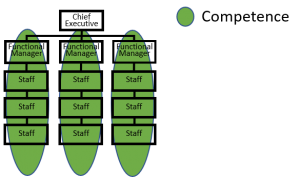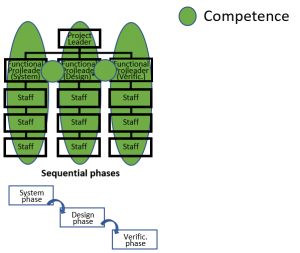This series of blog posts will go through the “to solve” part of our start organisation definition, and finally the principle it will generate.
So far, we had for the sake of simplicity, made a division into people side and system product side, but now it is time to look how they really effect each other. So, these couple of blog posts will show that it is many times not possible to state that an organisation is resource efficient or flow efficient, rather than that an organisation is either efficient or inefficient, or most common somewhere in between. And we continue to use the silo organisation with projects as an example, since it is very easy to understand. Let us start.
In order for the people in our organisation to solve any activities, they need of course the right I-competence for our business, which was one of the principles from the first part of the start organisation definition “People that interact to solve activities with interdependencies for a common purpose*”.
But, if everyone only have I-competence it will be impossible to interact, so some sort of broad competence is needed. We start with looking into the competence within a silo organisation before the introduction of projects. And remember that before work is started in a silo, it is normally a released specification to be followed, which means it is ordered work.

Here we can state that each silo has its own I-competence, compared to their silo. But, of course within the silo some broad competence are needed in order to solve their own tasks. If we add projects with waterfall way of working to the silo organisation, it looks like this.

As we can see now, there is a need of at least the hand-over competence between the sub-projects at the phase shift, but that is more for the sub-project managers, not as much for the other members of the silo teams. Each silo still gets a released specification before they start their work, instead the difference lies in the coordination, structure and responsibility that came with the introduction of projects.
In tomorrow’s blog post we will continue with semi-parallel work, and what then happens with the competence. C u then.
*With organizational purpose means; manufacture a product, service, develop a new product, etc., with a certain price and quality. We are not talking about the nowadays popular Purpose statement, that is only a continuation of the easy-gamed value and mission statements. In this kind of statements, behaviour, properties and core values of our employees are stated, which is more of wishful thinking, since they will only emerge from multiple interactions within the organization. Since the interactions in turn, also emerge from our way of working, one can believe that if the purpose of the organization is not fulfilled, neither will the emergent behaviour and properties of our organization be what one could wish for.

